We are back with another article on animals with yellow eyes, after the one about black-eyed creatures. According to a study, yellow eye color is the second most common eye color in animals after brown. You can find various shades of yellow eyes in animals, from golden yellow to amber. In this blog post, we will see how the yellow coloration of the eyes of these animals is different from each other. So let’s start with the list of 30 animals with yellow eyes.
30 Animals with Yellow Eyes
1. Royal Bengal Tiger
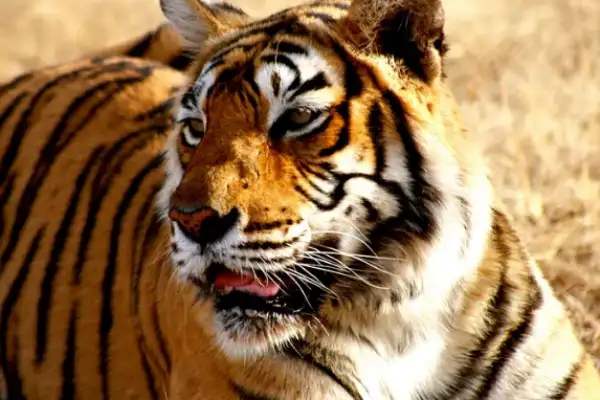
- Scientific name: Panthera tigris tigris
- Size: 163 to 211 cm
- Habitat: Tropical moist evergreen forests, tropical dry forests, tropical and subtropical moist deciduous forests, mangroves
- Diet: Primarily feeds on large ungulates such as gaur, sambar, chital, bara Singha, Water buffalo, nilgai, serow, and takin
You must have seen a tiger once in your life—not in real life, but maybe in pictures, right?
They are enhancing the beauty of the Indian subcontinent from the Pleistocene era.
The Royal Bengal tiger is orangish-yellow in color with black or brown stripes all over the body.
Their eyes are yellow or amber in color, have binocular vision, and are adapted to have a clear view at night.
2. Red Fox
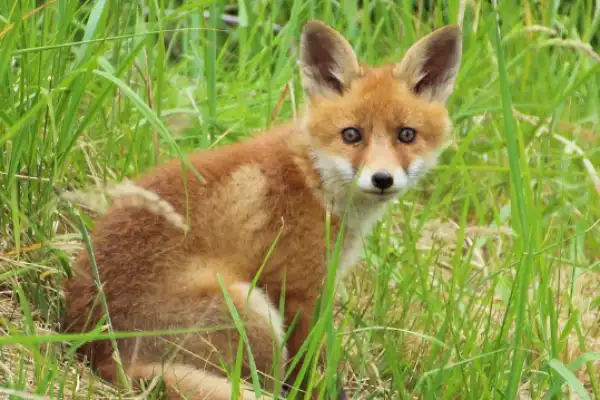
- Scientific name: Vulpes vulpes
- Size: 76.7–105.3 cm
- Habitat: Forests, grasslands, mountains, and deserts
- Diet: small rodents, squirrels, woodchucks, rabbits, birds and eggs, amphibians, reptiles, fruits and vegetables.
In the next one, we have one of the largest true foxes on our list of animals with yellow eyes, i.e., the red fox.
As their name implies, they are reddish brown in coloration, but different color morphs are also seen in nature.
Scent glands, like caudal glands, in this creature smell like violets. The most interesting thing about them is that urine, despite being a waste, plays a major role in marking their territories.
Now about their eyes: they have bright yellow eyes, which impart different colorations when seen from different angles.
3. Cobra
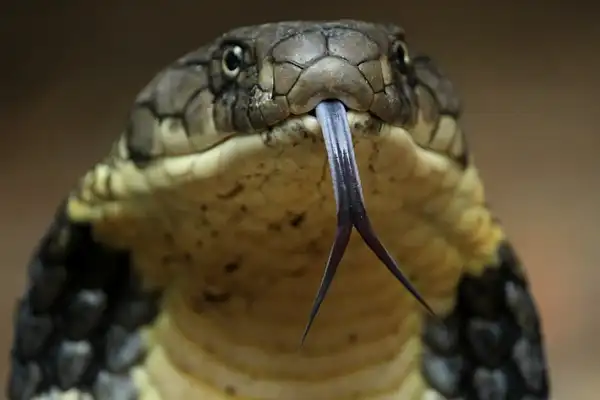
- Scientific name: Naja naja
- Size: 1 to 1.5 meters (3.3 to 4.9 ft.)
- Habitat: dense or open forests, plains, agricultural lands, rocky terrain, wetlands
- Diet: rodents, frogs, and lizards
The Indian cobra, or Naja naja, is one of the four largest snakes in India and is thought to be the cause of the majority of snakebite incidents.
This venomous creature is easily identified by its characteristic hood with a distinctive mark on it.
Their eyes are black with bands of yellow surrounding them.
Their venom contains a lot of neurotoxic and cardiotoxic chemicals, which have the ability to paralyze the host or, in more severe cases, cause cardiac arrest.
4. Bald Eagles
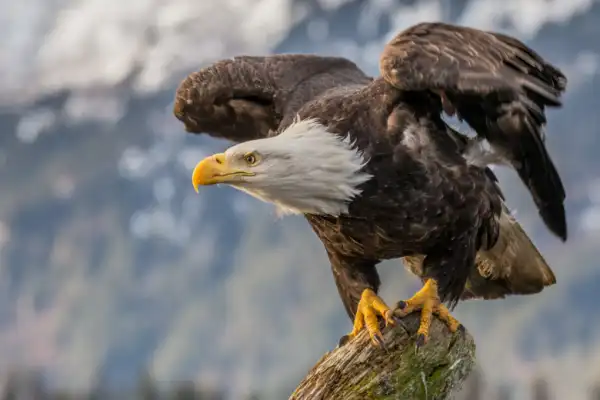
- Scientific name: Haliaeetus leucocephalus
- Size: 70–102 cm (28–40 in)
- Habitat: lakes and reservoirs with lots of fish and surrounding forests
- Diet: Primarily on fishes
Look at these bald eagles; they have something remarkable about them, which is their eye coloration, which changes with age.
Their eyes are brown in color when they are young; with age, they change to yellow. They have 20/5 vision and also have the ability to see ultraviolet light easily.
The plumage of the bald eagle is very common, as you have probably seen in your textbooks or in some articles: they are dark brown in color with a white head and tail.
You must be wondering why they are called bald eagles because they have a white head that is distinctly feathered.
5. Yellow-eyed Penguin
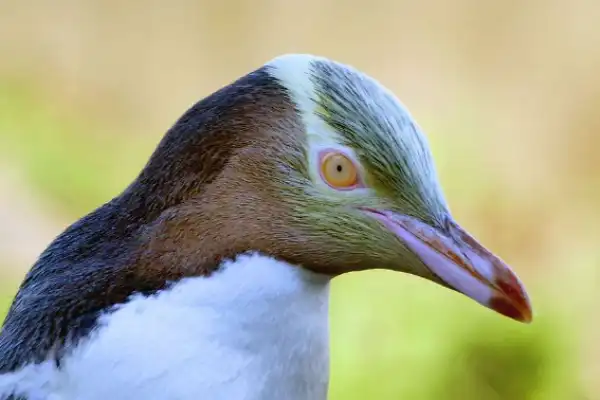
- Scientific name: Megadyptes antipodes
- Size: 62–79 centimeters (24–31 in)
- Habitat: dense coastal forests and hilly shrubland of the South Island
- Diet: red cod, opal fish, sprat, squid, etc.
Just look at these species of penguins; don’t they look unusual compared to typical penguins?
Megadyptes antipodes, or yellow-eyed penguins, are the unique name for these species.
People can find them on the eastern and south-eastern coastlines of the South Island of New Zealand.
As their name suggests, they have pale yellow eyes and a band of pale yellow feathers that surrounds their eyes and heads.
6. Yellow-eyed Junco
- Scientific name: Junco phaeonotus
- Size: 5.5-6.3 in (14-16 cm)
- Habitat: Open Woodlands, Mountain forests
- Diet: Seeds, insects, and spiders
This new world sparrow, yellow-eyed Junco, is known for its bright yellow eyes and a two-toned bill.
One can spot them easily in southern Arizona and New Mexico. Let’s talk about their appearance.
They are gray in color with brown feathers on their back. And about their face, their yellow eyes are lined by a black band, as you can see in this given picture.
Song, struts, and tail spreading are some of the courtship displays males exhibit in their breeding season.
7. Pharaoh Eagle Owl
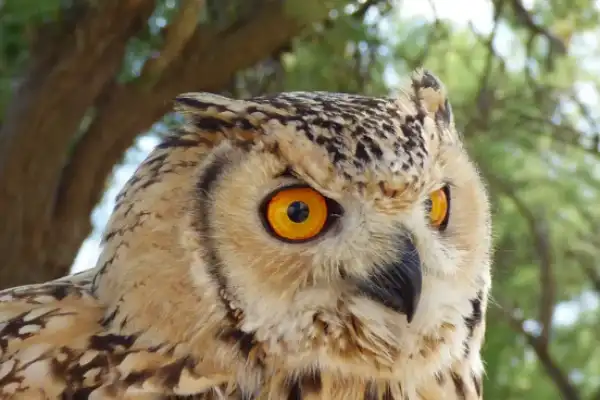
- Scientific name: Bubo ascalaphus
- Size: 46–50 cm (18–20 in)
- Habitat: rocky outcrops, plains, wadis and cliffs
- Diet: Mammals, birds, snakes, lizards, beetles and scorpions
The striking appearance and regal demeanor of these owls highly resemble those of the Egyptian pharaoh.
Their reddish-brown vermiculations, white underparts, and large yellow eyes give them an incredible look.
They are quite aggressive and have remarkable hunting abilities, which makes them fascinating for biologists.
Unlike most animals, they are monogamous, which means they spend their lives with only one partner.
8. Lion
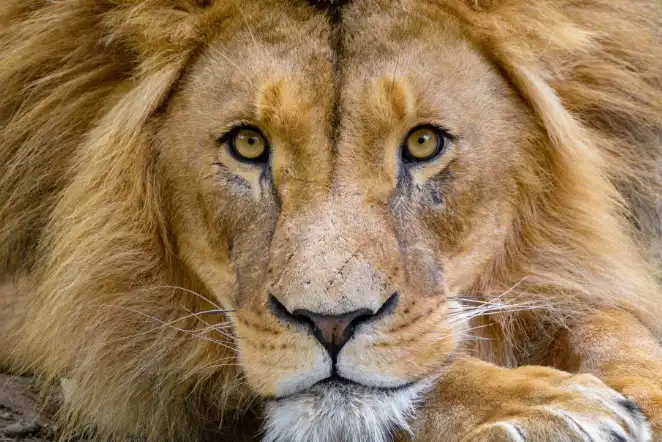
- Scientific name: Panthera leo
- Size: 160-208 cm
- Habitat: grassy plains, savannahs, scrub bordering rivers, and open woodlands with bushes
- Diet: Primarily on ungulates
The cub’s eyes are blue-grey at birth but change with time; their eye color changes to an amber or deep golden hue.
As you all know, they are yellowish-red to brown in color, with characteristic manes in males.
They are so lazy that they spend at least twenty hours per day resting.
A lot of greeting signs are seen in these creatures, like head rubbing and nuzzling the forehead, face, and neck against another lion.
9. Crocodiles
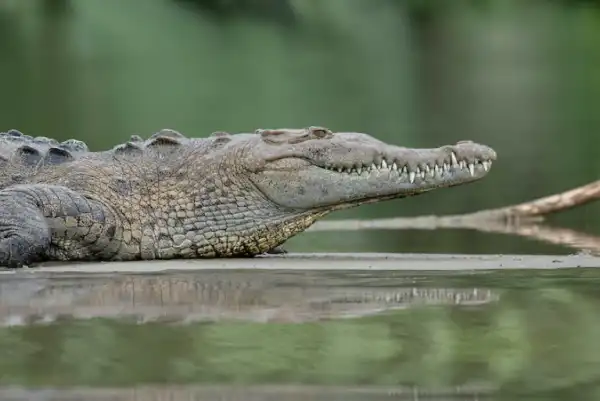
- Family: Crocodylidae
- Size: 1.5 to 6 m
- Habitat: freshwater habitats such as rivers, lakes, wetlands, and sometimes brackish water and saltwater.
- Diet: insects, fish, small frogs, lizards, crustaceans and small mammals
These aquatic animals are renowned for their strong jaws, pointed teeth, and intimidating looks.
V-shaped snouts are distinctive in these animals. They are the only reptiles with four-chambered hearts.
They don’t have the ability to sweat, so they release their heat from their mouth.
The eye color of a crocodile varies a lot, from green to yellow with a vertical pupil.
10. American Alligators
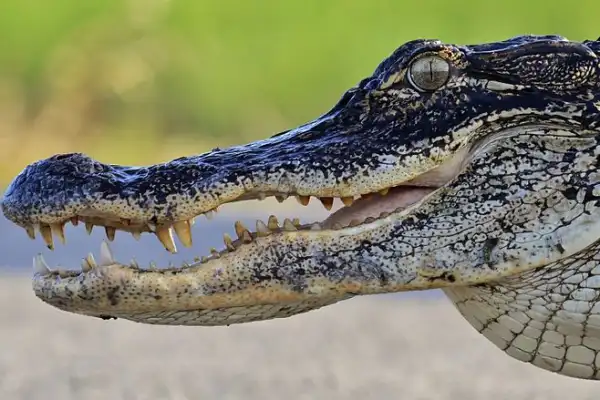
- Scientific name: Alligator mississippiensis
- Size: 8.2 to 11.2 feet
- Habitat: freshwater, slow-moving rivers
- Diet: fish, snails, birds, frogs and mammals
People often get confused between crocodiles and alligators, as they look somewhat similar in appearance.
Alligators have a U-shaped snout, whereas crocodiles have a narrow V-shaped snout.
They are black to gray in color with cream undersides. Just like cats, their eyes also glow in the dark, which is surely going to scare you
. The most interesting thing about them is that their sex is determined by temperature.
Yes, you heard it right. At elevated temperatures, they become males and at low temperatures, they become females. Talking about their eyes, they are yellow to brown in color.
11. Yellow eyelash viper
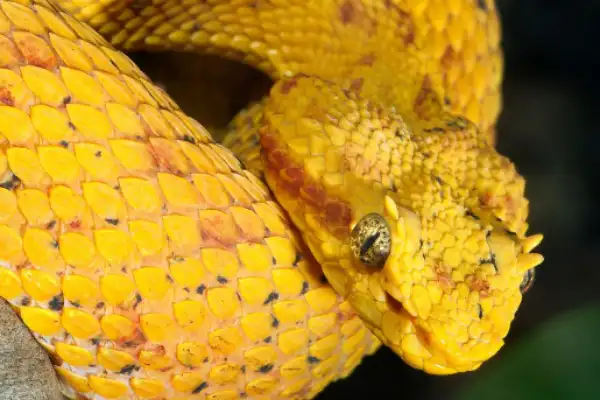
- Scientific name: Bothriechis schlegelii
- Size: 50 to 80 cm
- Habitat: Densely-wooded, sea-level forests; streamside vegetation in moist lowlands and foothills; wooded cloud and montane forests
- Diet: small rodents, frogs, lizards, and small birds
This yellow eyelash pit viper is known for its golden eyes with vertical pupils and scales above the eyes, which give it an eyelash appearance.
This Central American native snake is deadly venomous with neurotoxic and hemostatic venom, which leads to death.
They are polygynous and do some unique courtship displays.
Males of this species intimidate each other by mimicking cobra-like hoods, in which one of them wins and mates with a female. This unique display is known as the dance of the adders.
12. Snowy owl
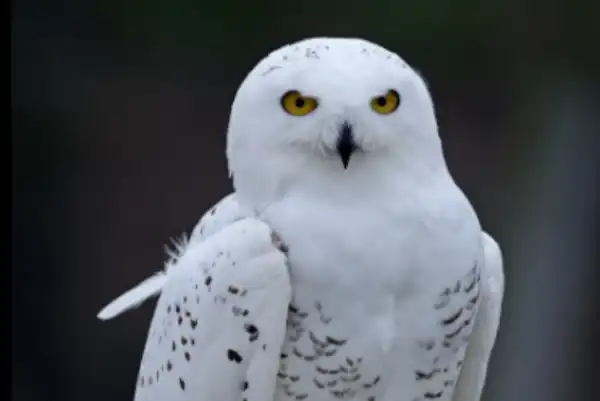
- Scientific name: Bubo scandiacus
- Size: 20.5-27.9 in (52-71 cm)
- Habitat: Arctic tundra
- Diet: lemmings, Arctic hares, mice, ducks and seabirds
I’m sure you’re wondering why this fuzzy blanket is covering these owls. Let me tell you that below all of this fuzzy covering is their feathered skin.
These snowy owls are different from other owls as they are diurnal
They are white in color with brown specklings all over their body, and their eyes are bright yellow in color.
In order to defend their territory, they become so aggressive against other animals.
13. Wolf
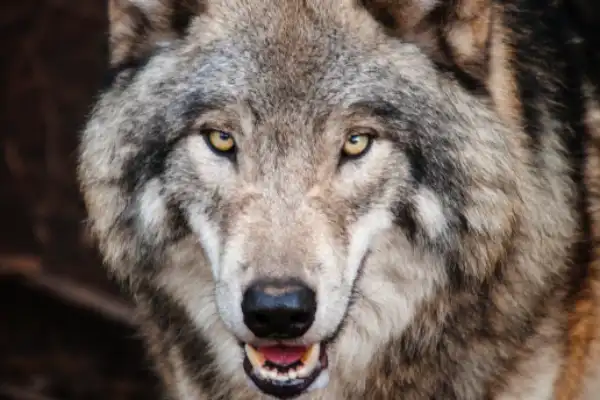
- Scientific name: Canis lupus
- Size: 36 to 63 inches
- Habitat: temperate forests, mountains, tundra, taiga, grasslands and deserts
- Diet: antelopes, rodents, hares, and raccoons
You must read about the alpha wolf in various tales. People usually connect this term with dominance, but in reality, alpha wolves are the breeding population of wolves.
They are monogamous and stay with one partner for their whole lives. They exist in different colors, from red to gray, and mostly have yellow eyes with shades of orange, amber, and green.
Body language, whines, barks, whimpers, eye contact, postures, and facial expressions are some of the ways in which they communicate.
14. Burmese cats
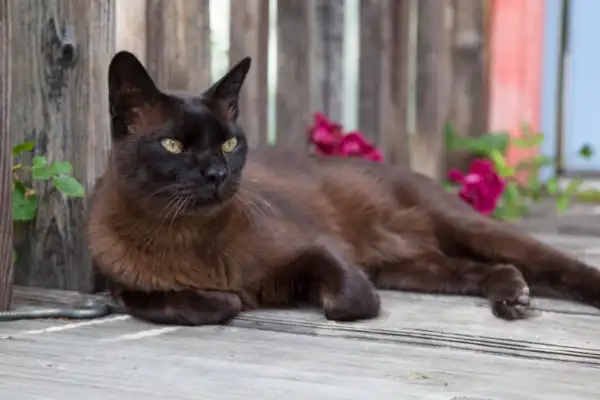
- Scientific name: Felis catus
- Size: 15”-18” (38-46 cm)
- Habitat: Burma, Asia
- Diet: mainly animal protein
They are the ideal breed of companion cats because of their loving, perceptive, and lively personalities.
15. Yellow-eyed babbler
- Scientific name: Chrysomma sinense
- Size: up to 18 cm
- Habitat: shrubland, grassland and wetland habitats
- Diet: Caterpillars, Grasshoppers, Other insects, Spiders, Lantana berries, Salvadora persica berries, Erythrina nectar, Salmalia nectar
Their eyes are surrounded by an orangish yellow ring, as their name, yellow-eyed babbler, suggests, giving them a unique look.
They often live in settings that are shrubland, grassland, or wetland in south and southeast Asia.
This beauty can easily catch anyone’s eye with its cinnamon-colored wings. They are very social and live in groups of around 15 birds.
16. Coquerel’s Sifaka
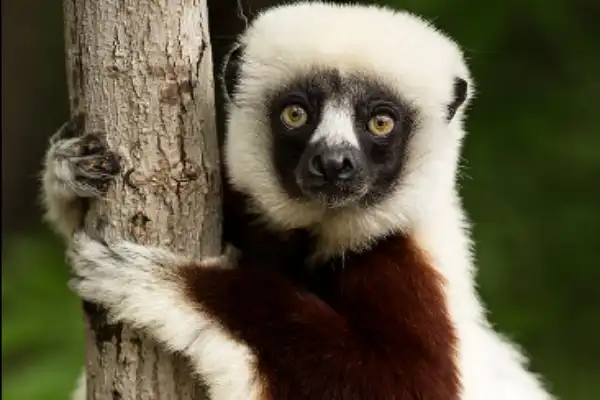
- Scientific name: Propithecus coquereli
- Size: 16–20 in. (42.5–50 cm)
- Habitat: tropical-dry and lowland forests
- Diet: Flowers, Fruit, Bark, Deadwood, Insects, Seeds
You must be wondering which animal it is. This Coquerel’s Sifaka is a lemur species found in northern Madagascar.
Let’s talk about their appearance. Their appearance is distinct, with a white body, brown patches on the chest or limbs, and a characteristic black face. They have either orange or yellow eyes.
This critically endangered animal mostly depends on a vegetarian diet like flowers, fruit, bark, dead wood, seeds, and sometimes insects as well. They go here and there by vertically clinging and leaping.
17. Tarsiers
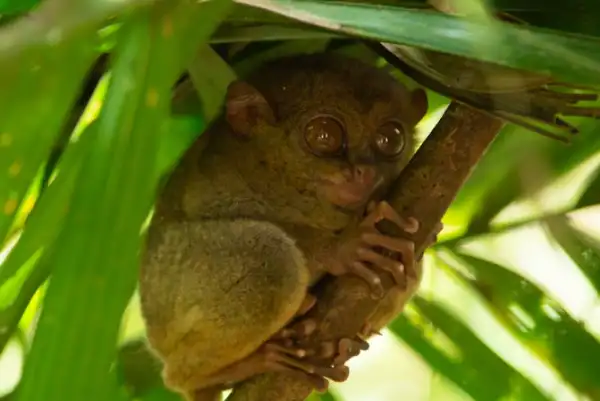
- Family: Tarsiidae
- Size: 9–16 cm (3.5–6 inches)
- Habitat: rainforests, scrub forests, mangroves, and even garden or agricultural areas
- Diet: mainly on arthropods
These enormous yellow eyes with a hint of brown hue surely amaze to the core. Their eyes are as big as their brains, or even more than that sometimes.
Their ability to leap and cling vertically is due to their peculiar structure, which includes an enlarged tarsus.
When these animals are held in captivity, their shyness often leads them to commit suicide.
Their diet mostly consists of arthropods, including spiders, beetles, termites, cicadas, ants, moths, caterpillars, katydids, crickets, grasshoppers, and cockroaches.
18. Ring-tailed lemur
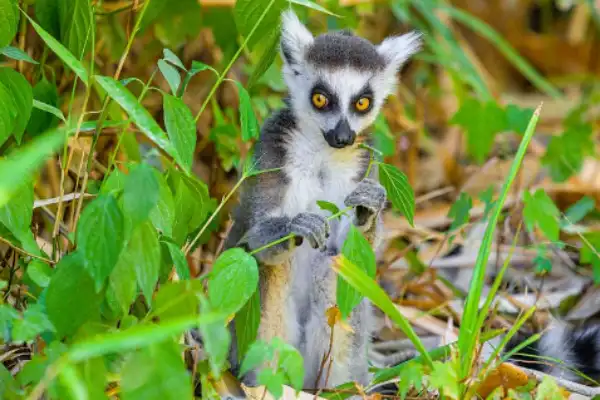
- Scientific name: Lemur catta
- Size: 15.4”-18.1” (39-46 cm)
- Habitat: deciduous forests, dry scrub, montane humid forests, and gallery forests
- Diet: leaves, flowers, and insects
Now we have another lemur species on the list of animals with yellow eyes. By this time, you must have an idea why I included them in this list. Just look at their eyes; they have big, bright yellow eyes with black pupils.
In juvenile stages, their eyes are blue, but with time, the color changes.
Their common name is derived from the 13 alternative black and white bands that give them a ring-like appearance on the tail.
They communicate with other members of the group through their tails and scents.
19. Trimeresurus Macrops
- Scientific name: Trimeresurus macrops
- Size: up to 71cm
- Habitat: fully arboreal
- Diet: small mammals (rats and mice), birds, lizards and frogs
This snake sticks out from the others because of its vivid green hue and golden eyes.
Here is the venomous snake of southeast Asia Trimeresurus macrops.
Their venom is so toxic that it can even cause prolonged clotting time, tissue damage, and hematotoxicity in humans.
The female vipers pull the males up the trees to mate, this demonstrates how different their mating habits are.
20. Norwegian forest cat
- Scientific name: Felis catus
- Size: 12 to 18 inches
- Habitat: open woodlands, second-growth forests, and woodland edges
- Diet: mainly animal protein
The Norwegian Forest Cat is distinguished by its thick tail, tufted ears, long, opulent coat, and sturdy frame.
Their big almond eyes come in a variety of colors, although they are primarily amber in hue.
They are naturally rather kind and amiable, and they readily get fond of children.
21. Black Panther
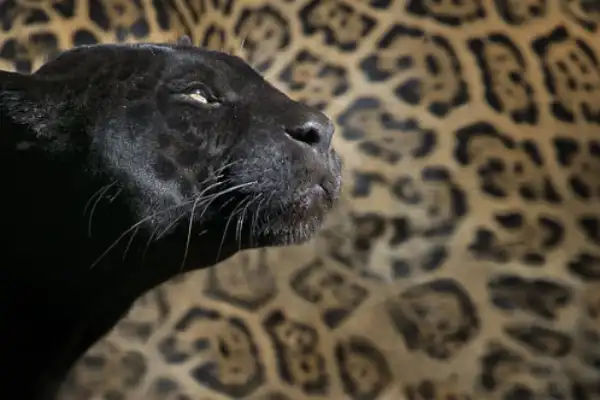
- Scientific name: Panthera
- Size: 37 to 65 inches
- Habitat: hot, dense tropical rainforests
- Diet: mainly wild hogs and boars, raccoons, and deer
Black panthers are derived from leopards and jaguars by a genetic mutation that causes hyperpigmentation due to excess melanin production.
They are commonly found in the tropical rainforests of South and Southeast Asia, including southwestern China, Burma, Nepal, India, Indonesia and southern Malaysia.
At birth, they have blue eyes, but as they get older, their eyes turn golden yellow.
22. Yellow-eyed rockfish
- Scientific name: Sebastes ruberrimus
- Size: up to 36 inches
- Habitat: rocky bottoms of oceans
- Diet: algae, other single-celled organisms, and small crustaceans
Yellow-eyed rockfish, or Sebastes ruberrimus, is a member of the Scorpaenidae family.
The striking red coloring and golden eyes of this rockfish are well-known features.
They have a life span of 114 to 120 years, which makes them the longest-lived fish species on earth.
You can spot them in Alaska, British Columbia, and the West Coast of the United States.
23. American Oystercatcher
- Scientific name: Haematopus palliatus
- Size: 17 to 21 inches
- Habitat: rocky, sandy, or shell beaches, salt marshes and mudflats
- Diet: bivalves, mollusks, crustaceans, worms and other marine invertebrates
This American oystercatcher is easily recognized by its unique black and white plumage, knife-like orange beak, and yellow eyes surrounded by an orange ring.
As their name suggests, they feed mostly on shellfish, such as clams, oysters, and other saltwater molluscs.
One can spot them running on the Atlantic and Pacific coasts of the Americas.
24. Ring-billed gull
- Scientific name: Larus delawarensis
- Size: 46.9 to 50.2 cm
- Habitat: near lakes, rivers, or the coast
- Diet: insects, fish, earthworms, grain, and rodents
One of the larger seabirds in the genus Larus is the ring-billed gull. The black ring on the tip of their golden beak is what gave them their name. Like their beak, they have yellow eyes as well.
This omnivorous bird is an opportunistic feeder and mainly feeds on insects, fish, earthworms, grain, and rodents.
They are migratory and move from Canada and the United States to the south of the Gulf of Mexico, the Atlantic and Pacific coasts of North America, and the Great Lakes.
25. Osprey
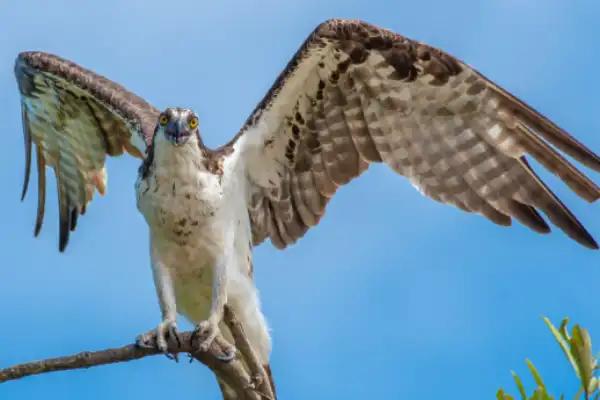
- Scientific name: Pandion haliaetus
- Size: 50 to 65 cm
- Habitat: near water, primarily lakes, rivers, and coastal waters
- Diet: mainly fishes
Seahawk, river hawk, and fish hawk are some of the common names of Pandion haliaetus.
They are large, fish-eating birds with a white head and distinctive brown eye stripes covering the enchanting yellow eyes.
This intelligent creature has sharp eyesight. Spiritually, they are considered a sign of positivity and symbolize vision and abundance.
Sky dance plays a very evident role in courtship in these species.
They live in the same nest throughout their lives; they do migrate, but they return to their place. Their eyes turn yellow from orange when they mature.
26. Golden pheasant
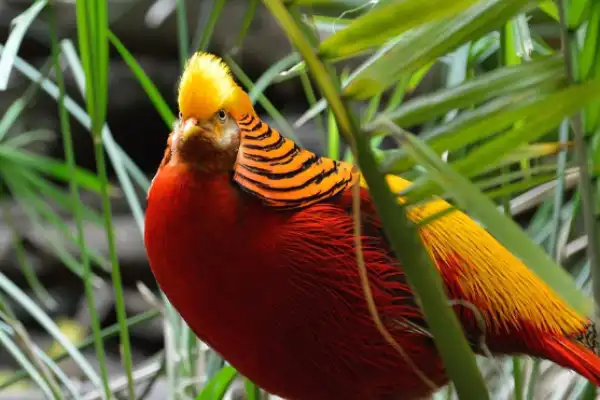
- Scientific name: Chrysolophus pictus
- Size: 65-75 cm
- Habitat: mountainous forests
- Diet: berries, grubs, seeds, leaves, tender shoots of shrubs and bamboo, some flowers
The golden pheasant is distinguished by its vivid orange and yellow feathers, which have black borders around its wings.
Their bodies were decorated in shades of red, orange, yellow, green, and blue.
This bird is distinguished by its pinpoint black pupil and golden eye. Compared to males, female coloring is duller.
Being herbivores, their main sources of food include berries, grubs, seeds, leaves, delicate bamboo and shrub shoots, certain flowers, and other kinds of vegetation.
27. Bobcats
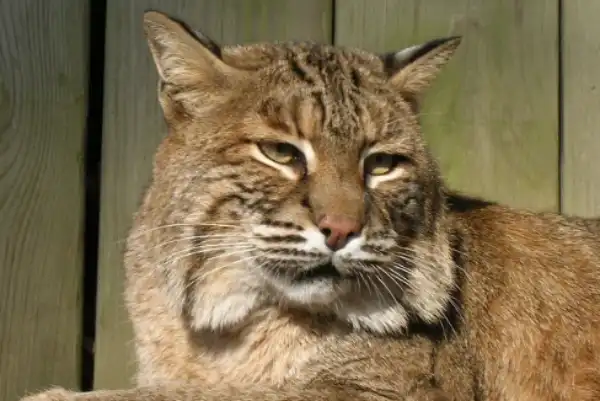
- Scientific name: Lynx rufus
- Size: 20 to 50 inches
- Habitat: boreal coniferous and mixed forests
- Diet: mostly rabbits and hares
People often mistake bobcats for Eurasian lynxes due to their similar tannish brown coats.
They are carnivorous and like to feed on smaller mammals such as rabbits, mice, moles, and squirrels.
Their sense of hearing, vision, and olfaction are way too good.
These nocturnal creatures have yellow eyes with round black pupils.
You can find them in North America, inhabiting forests, semi-deserts, mountains, and brushlands.
28. Manx
- Scientific name: Felis catus
- Size: 7 to 11 inches
- Habitat:
- Diet: mainly animal protein
Manx is the cat breed that originated on the Isle of Man. They are mostly entirely tailless because of genetic mutations.
This cat’s distinctive traits include a round head, a wide chest, and large, round yellow eyes.
They are more devoted, affectionate, and trained like dogs or rabbits.
Manx syndrome is the term for the disease when a person’s tailless gene causes their spine to shorten to such an extent that it damages the spine and causes several serious difficulties.
29. Sparrow hawk
- Scientific name: Accipiter nisus
- Size: up to 80 cm
- Habitat: dense woodland
- Diet: mainly small birds
The red-brown undertail and characteristic black wing patch of the sparrow hawk are well-known features.
Just look at their eyes; they have greenish-yellow eyes that change their hue during their lifetime.
When we look at all the birds, we notice that the females are the largest, with a five percent bigger size than the males.
They create a lot of havoc in small birds as they feed on them.
30. Black Currawong
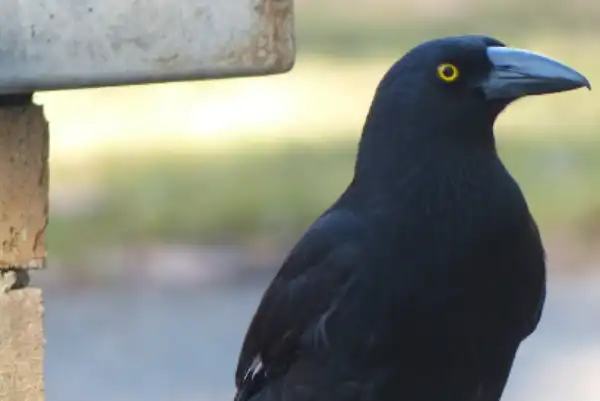
- Scientific name: Strepera fuliginosa
- Size: up to 50 cm
- Habitat: mountain and lowland forests, coastal heath, grazing lands and suburban areas
- Diet: young birds, carrion, insects and berries
The Black Jay, or Black Currawong, is a medium-sized bird endemic to Tasmania.
They have golden eyes, a hefty beak, and white spots on their black wings.
During the winter, they migrate altitudinal, moving downhill from chilly, snow-covered highlands to lowland woods and urban areas.
These omnivorous species feed on a variety of organisms, like berries, seeds, invertebrates, bird eggs, juvenile birds, and young marsupials.
With this, we come to the end of our article on animals with yellow eyes.
I hope you find it interesting to know about these beauties.
We will be back with another article soon. Until then, try to observe this species in nature.
Also Read:

Being a zoology student I’m always been fascinated toward animals especially insects. I love to do research and learn about different animals. As a writer I want to share my thoughts about nature through my articles. Apart from this you can find me exploring the new places and voice notes.
